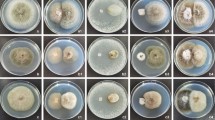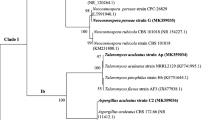Abstract
Endophytes are microorganisms that live inside plant tissues throughout its life cycle and during certain phases of development. The endophyte–host relationships can provide benefits to the host, protecting it against attack by insects and diseases. Several studies have demonstrated the diversity of endophytes from Coffea arabica, but few studies in varieties of organic crops. Thus, the objective in this study was to corroborate these reports with knowledge of the endophytic fungi communities in an organic variety of C. arabica L. cultivar IAPAR-59. We identified the endophytic fungi by molecular methods using the ITS1-5.8S-ITS2 region of rDNA and phylogenetic analyses. In the antagonist activity tests, the endophytes were tested against phytopathogens with the evaluation of the kind of interactions between them. Analyses demonstrated a diversity of genera, including: Colletotrichum, Trichoderma, Schizophyllum, Mycosphaerella, Cladosporium, and Cercospora, as well as the first record of the genus Ophiognomonia in C. arabica. The antagonist activity showed reduced growth of the phytopathogenic fungi Glomerella sp., Colletotrichum sp. and Sclerotinia sclerotiorum. The results obtained in this work, with the identification for the first time, of a highly diverse isolated endophytic of the species Ophiognomonia sp. in the coffee plants, is the second report of the detection of these fungi in Brazil. Also, the detection of different isolates with the ability to antagonise pathogens, emphasises the importance of further research, involving the isolation, identification and exploration of endophytes of other genetic varieties of coffee, obtained by breeding programs of this important crop in Brazil.



Similar content being viewed by others
References
Almeida TT, Orlandelli RC, Azevedo JL, Pamphile JA (2015) Molecular characterization of the endophytic fungal community associated with Eichhornia azurea (Kunth) and Eichhornia crassipes (Mart.) (Pontederiaceae) native to the Upper Paraná River floodplain, Brazil. Genet Mol Res 14(2):4920–4931
Azevedo JL, Maccheroni W Jr, Pereira JO, Araújo WL (2000) Endophytic microrganisms: a review on insect control and recent advances on tropical plants. EJB Eletronic J Biotechnol 3:40–65
Badalyan SM, Innocenti G, Garibyan NG (2002) Antagonistic activity of xylotrophic mushrooms against pathogenic fungi of cereals in dual culture. Phytopathol Mediterr 41:200–225
Badri DV, Chaparro JM, Zhang R, Shen Q, Vivanco JM (2013) Application of natural blends of phytochemicals derived from the root exudates of Arabidopsis to the soil reveal that phenolic-related compounds predominantly modulate the soil microbiome. J Biol Chem 288(7):4502–4512
Bernardi-Wenzel J, Garcia A, Filho CJR, Prioli AJ, Pamphile JA (2010) Evaluation of foliar fungal endophyte diversity and colonization of medicinal plant Luehea divaricata (Martius et Zuccarini). Biol Res 43:375–384
Cai L, Hyde KD, Taylor PWJ, Weir BS, Waller J, Abang MM, Zhang JZ, Yang YL, Phoulivong S, Liu ZY, Prihastut H, Shivas RG, McKenzie EHC, Johnston PR (2009) A polyphasic approach for studying Colletotrichum. Fungal Divers 39:183–204
Camatti-Sartori V, Silva-Ribeiro RT, Valdebenito-Sanhueza RM, Pagnocca FC, Echeverrigaray S, Azevedo LL (2005) Endophytic yeasts and filamentous fungi associated with southern Brazilian apple (Malus domestica) orchards subjected to conventional, integrated or organic cultivation. J Basic Microbiol 45:397–402
Campanile G, Ruscelli A, Luisi N (2007) Antagonistic activity of endophytic fungi towards Diplodia corticola assessed by in vitro and in planta tests. Eur J Plant Pathol 117:237–246
Carvalho DC, Brigagão MRPL, Santos MH, Paula FBA, Giusti-Paiva A, Azevedo L (2011) Organic and conventional Coffea arabica L.: a comparative study of the chemical composition and physiological, biochemical and toxicological effects in wistar rats. Plant Foods Hum Nutr 66(2):114–21
Chen CA, Chang C-C, Wei NV, Chen C-H, Lein Y-T, Lin Ho-E, Dai C-F, Wallace CC (2004) Secondary structure and phylogenetic utility of the Ribosomal Internal Transcribed Spacer 2 (ITS2) in Scleractinian corals. Zool Stud 1021–5506
Ferreira DF (2011) Sisvar: a computer analysis system. Ciênc Agrotec 35:1039–1042
Gangadevi V, Muthumary J (2008) Isolation of Colletotrichum gloeosporioides, a novel endophytic taxol-producing fungus from the leaves of a medicinal plant, Justicia gendarussa. Mycol Balc 5:1–4
Garcia A, Rhoden AS, Rubin Filho CJ, Nakamura CV, Pamphile JA (2012) Diversity of foliar endophytic fungi from the medicinal plant Sapindus saponaria L. and their localization by scanning electron microscopy. Biol Res 45:149–158
Gosling P, Hodge A, Goodlass G, Bending GD (2006) Arbuscular mycorrhizal fungi and organic farming. Agric Ecosyst Environ 113(1):17–35
Gottel NR, Castro HF, Kerley M, Yang Z, Pelletier DA, Podar M et al (2011) Distinct microbial communities within the endosphere and rhizosphere of Populus deltoides roots across contrasting soil types. Appl Environ Microbiol 77(17):5934–5944
Harman GE (2000) Myths and dogmas of biocontrol: changes in perception derived from research on Trichoderma harzianum T-22. Plant Dis 84:377–393
Kamalakannan A, Mohan L, Harish S, Radjacommare R, Amutha G, Chiara K, Karuppiah R, Mareeswari P, Rajinimala N, Angayarkanni T (2004) Biocontrol agents induce disease resistance in Phyllanthus niruri Linn against camping-off disease caused by Rhizoctonia solani. Phytopathol Mediterr 43:187–194
Kogel KH, Franken P, Huckelhoven R (2006) Endophyte or parasite-what decides? Curr Opin Plant Biol 9:358–363
Koulman A, Lane GA, Christensen MJ, Fraser K, Tapper BA (2007) Peramine and other fungal alkaloids are exuded in the guttation fluid of endophyte-infected grasses. Phytochemistry 68:355–360
Leite TS, Cnossen-Fassoni A, Pereira OL, Mizubuti ESG, Araújo EF, Queiroz MV (2013) Novel and highly diverse fungal endophytes in soybean revealed by the consortium of two different techniques. J Microbiol 51(1):56–69
Lima JS, Figueiredo JG, Gomes RG, Stringari D, Goulin EH, Adamoski D, Kava-Cordeiro V, Galli-Terasawa V, Glienke C (2012) Genetic diversity of Colletotrichum spp. an endophytic fungi in a medicinal plant, Brazilian pepper tree. ISRN Microbiol 2012:1–7
McGinnis S, Madden TL (2004) BLAST: at the core of a powerful and diverse set of sequence analysis tools. Nucleic Acids Res 32:20–25
Mónaco C, Sisterna M, Perelló A, Dal Bello G (2004) Preliminary studies on biological control of the blackpoint complex of wheat in Argentina. World J Microbio Biotechnol 20(3):285–290
Moreno E, Varughese T, Spadafora C, Arnold AE, Coley PD, Kursar TA, Gerwick WH, Cubilla-Rios L (2011) Chemical constituents of the new endophytic fungus Mycosphaerella sp. nov. and their anti-parasitic activity. Nat Prod Commun 6(6):835–840
Oliveira RJV, Souza RG, Lima TEF, Cavalcanti MAQ (2014) Endophytic fungal diversity in coffee leaves (Coffea Arabica) cultivated using organic and conventional crop management systems. Mycosphere 5(4):523–530
Orlandelli RC, Alberto RN, Rubin Filho CJ, Pamphile JA (2012) Diversity of endophytic fungal community associated with Piper hispidum (Piperaceae) leaves. Genet Mol Res 11:1575–1585
Pamphile JA, Azevedo JL (2002) Molecular characterization of endophytic strains of Fusarium verticillioides (Fusarium moniliforme) from maize (Zea mays L). World J Microb Biotechnol 18:391–96
Petrini O (1991) Fungal endophyte of tree leaves. In: Andrews J, Hirano SS (eds) Microbial ecology of leaves. Springer Verlag, New York, pp 179–197
Rhoden SA, Garcia A, Rubin Filho CJ, Azevedo JL, Pamphile JA (2012) Phylogenetic diversity of endophytic leaf fungus isolates from the medicinal tree Trichilia elegans (Meliaceae). Genet Mol Res 11:2513–2522
Rhoden SA, Garcia A, Azevedo JL, Pamphile JA (2013) In silico analysis of diverse endophytic fungi by using ITS1-5.8S-ITS2 sequences with isolates from various plant families in Brazil. Genet Mol Res 12:935–950
Saitou N, Nei M (1987) The neighbour-joining method: a new method for reconstructing phylogenetic trees. Mol Biol Evol 4:406–425
Salgado SML, Resende MLV, Campos VP (2005) Reprodução de Meloidogyne exigua em cultivares de cafeeiros resistentes e suscetíveis. Fitopatol Bras 30(4):413–415
Santamaría J, Bayman P (2005) Fungal epiphytes and endophytes of coffee leaves (Coffea arabica). Microb Ecol 50:1–8
Schubert K, Braun U (2004) Taxonomic revision of the genus Cladosporium s. lat. 2. Cladosporium species occurring on hosts of the families Bignoniaceae and Orchidaceae. Sydowia 56:296–317
Schulz B, Boyle C (2005) The endophytic continuum. Mycol Res 109:661–686
Sera GH, Sera T, Fonseca ICB, Ito DS (2010) Resistance to leaf rust in coffee cultivars. Coffee Sci 5:59–66
Sette LD, Passarini MRZ, Delarmelina C, Salati F, Duarte MCT (2006) Molecular characterization and antimicrobial activity of endophytic fungi from coffee plants. World J Microbiol Biotechnol 22:1185–1195
Shiomi HF, Melo IS, Minhoni MTA (2008) Selection of endophytic bacteria with antagonic action against plant pathogens. Sci Agrár 9:535–538
Silva JL, Souza PE, Monteiro FP, Freitas MLO, Júnior S, Belan LL (2014) Antifungal activity using medicinal plant extracts against pathogens of coffee tree. Revista Brasileira de Plantas Medicinais 16(3):539–544
Souza AO, Pamphile JA, Rocha CLMSC, Azevedo JL (2004) Plant-microbe interactions between maize (Zea mays L.) and endophytic microorganisms observed by scanning electron microscopy. Acta Sci Biol Sci 26(3):357–359
Teles HDF, Pires LL, Cunha MGD, Santos FPD, Ameloti Neto F (2013) Incidence of Sclerotinia sclerotiorum and the physical and physiological quality of soybean seeds based on processing stages. J Seed Sci 35(4):409–418
Tommerup IC, Briggs GG (1981) Influence of agricultural chemicals on germination of vesicular-arbuscular endophyte spores. Trans Br Mycol Soc 76(2):326–328
Vega FE, Posada F, Aime MC, Pava-Ripoll M, Infante F, Rehner AS (2008) Entomopathogenic fungal endophytes. Biol Control 46:72–78
Vega FE, Simpkins A, Aime MC, Posada F, Peterson SW, Rehner SA, Infante F, Castillo A, Arnold AE (2010) Fungal endophyte diversity in coffee plants from Colombia, Hawaii, Mexico and Puerto Rico. Fungal Ecol 3:122–138
Walker DW, Castlebury LA, Rossman AY, Mejía LC, White JF (2012) Phylogeny and taxonomy of Ophiognomonia (Gnomoniaceae, Diaporthales), including twenty-five new species in this highly diverse genus. Fungal Divers. doi:10.1007/s13225-012-0200-y
Waller JM, Bridge PD, Black R, Hakiza G (1993) Characterization of the coffee berry disease pathogen, Colletotrichum kahawae sp. nov. Mycol Res 97(8):989–994
Xia Y, DeBolt S, Dreyer J, Scott D, Williams MA (2015) Characterization of culturable bacterial endophytes and their capacity to promote plant growth from plants grown using organic or conventional practices. Front Plant Sci 6:1–10
Zak DR, Holmes WE, White DC, Peacock AD, Tilman D (2003) Plant diversity, soil microbial communities, and ecosystem function: are there any links?. Ecol 84(8):2042–2050
Zervakis GI, Moncalvo J-M, Vilgalys R (2004) Molecular phylogeny, biogeography and speciation of the mushroom species Pleurotus cystidiosus and allied taxa. Microbiology 150:715–726
Acknowledgments
We thank the Complex Research Support Centres (COMCAP-UEM), Laboratory of Molecular Biology and Structural for the facilities provided in the sequencing of ITS1-5.8S-ITS2 regions, and the Coordenação de Aperfeiçoamento de Pessoal de Nível Superior (CAPES) for granting the scholarship. Additional acknowledgments are given to CNPq (311534/2014-7; 447265/2014-8) and Fundação Araucária – FA (276/2014) for financial support.
Author information
Authors and Affiliations
Corresponding author
Rights and permissions
About this article
Cite this article
Bongiorno, V.A., Rhoden, S.A., Garcia, A. et al. Genetic diversity of endophytic fungi from Coffea arabica cv. IAPAR-59 in organic crops. Ann Microbiol 66, 855–865 (2016). https://doi.org/10.1007/s13213-015-1168-0
Received:
Accepted:
Published:
Issue Date:
DOI: https://doi.org/10.1007/s13213-015-1168-0




